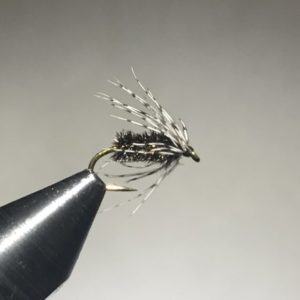TL;DR: Syl’s Midge is a go-to wet fly when trout are active but picky. One of my favorites.
I first read about this pattern in Dave Hughes’ book, Handbook of Hatches: A Basic Guide to the Food Trout Eat and the Most Effective Flies to Match Them. He rapturously writes about how incredibly effective it has been for him.
His intro to the fly was when he fished next to Sylvester Nemes himself, who was crushing it with the Syl’s Midge.
So, I tied a few and fished it a couple of times. They worked like crazy. I always have some in my fly box.
This fly is now one of my most effective wet flies, along with my CDC Soft Hackle in olive-brown. I fish it as a dropper on a nymph rig or as a trailing fly behind a white streamer. That is a particularly good combination: a large and bright fly coupled with a small and subtle one.

I really like flies that are easy to make and work well. Here is the materials list:
- Hook: scud or nymph hook, sizes 16 to 20
- Body: peacock herl, counter-wrapped with tippet for durability
- Wing: hackle, Hungarian Partridge
- Thread: UTC, 70 denier, black
Discover more from BlogFlyFish.com
Subscribe to get the latest posts sent to your email.

Fishes well dry too.
Will try that!
Thanks for the post! I am headed down to the Cape this weekend for some salt water action, but will be hitting a few freshwater ponds for some stocked trout. I know that I should be using a long leader and tippet on still, open water and was wondering if I should use a two fly set up with a dry-dropper or streamer and midge trailer or if its better to just go with a single fly. Also, a little off subject, but I was curious how I should be breaking down my rod in between outings. I have noticed that my leader has been bent in places from the guides after being stored with a fly still attached and the rod in two pieces. I guess my question is: should I be removing the fly after every outing and storing all the line, leader, and tippet in the reel? Thanks for you help, guidance, and info in your blog.
Hi Nate,
I don’t fish much stillwater, but the few times I do, I throw a weighted fly, like a JT Special or a Mop Fly. If I see fish chase and not take, I add a smaller fly behind that larger fly, like a small emerger or soft hackle.
If that doesn’t work, I will fish a single heavy fly on a jig-style hook and slowly crawl it along the bottom.
I do target structure and coves. Sometimes, you can find an area where there is a sudden and sharp drop-off, and that is a good spot, too.
Regarding storage, I leave my stuff on, and pull apart the rod in the middle. I then reverse the tip side of the rod so that it is pointing towards the reel, hook the fly at a guide along the tip end of the rod, tighten the line, and then take the line near the reel and wrap it around a guide a few times. I am using low-memory mono (Maxima Chameleon and Ultragreen) with home-made leaders, though.
If I were using a standard leader out of the pack, unfortunately, those things do kink up. But, if you heat up the kink between your fingers and then stretch it out, it should start to straighten out.
Hope that helps and good luck fishing at the Cape! I’m sure other readers will have good advice on fishing stillwater and storing their fly rods in between spots….
Thanks for the tips. Crossing my fingers for a good outing.
Also, FYI, MassWildlife is stocking in force right now. If you look at the map view and zoom in, you’ll see which stretches of which rivers, and which lakes/ponds, have been stocked.
Lucky for me they just stocked the lake I am hitting. Let’s hope they are hungry!
I must be blind, I cant seem to find the fly in the book. What page is it on?
Thanks,
Mike
Shoot. Will check and follow up.
I cannot find it either. So, I apologize for the error. I know I read about the pattern in a fly fishing book I have. It is how I first heard about it.
No problem, I guess I am not as blind as I thought I was.
Found it!
David Hughes’ book, Handbook of Hatches: A Basic Guide to the Food Trout Eat and the Most Effective Flies to Match Them.
I was trolling around the internet and found that Rich Strolis has a great fly tying video for the pattern on his vimeo page.